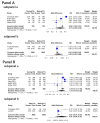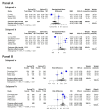Impact of COVID-19 mitigations on anxiety and depression amongst university students: A systematic review and meta-analysis
- PMID: 37655370
- PMCID: PMC10472203
- DOI: 10.7189/jogh.13.06035
Impact of COVID-19 mitigations on anxiety and depression amongst university students: A systematic review and meta-analysis
Abstract
Background: While much research has addressed mental health concerns related to the coronavirus disease 2019 (COVID-19) pandemic, there remains a scarcity of studies specifically exploring the changes in anxiety and depression among university students before and after the implementation of COVID-19 mitigation measures.
Methods: In this systematic review and meta-analysis, we searched databases including MEDLINE (Ovid), EMBASE (Ovid), PsycINFO (Ovid), CINAHL (EBSCO), ERIC (EBSCO), the WHO COVID-19 database, Scopus, and Science Citation Index (Web of Science) as of 15 February 2023. We included studies that used a validated tool to measure changes in anxiety or depression at two distinct time points - before (T1) and during (T2); during (T2) and after (T3); or before (T1) and after (T3) COVID-19 mitigation. The quality of studies was assessed using an adapted Joanna Briggs Institute Checklist for longitudinal studies. Utilising random-effects models, we synthesised changes in continuous outcomes as standardised mean difference (SMD) with 95% confidence interval (CI) and binary outcomes as risk difference (RD) with 95% CI.
Results: In total, 15 studies were included in this review, with eight of moderate and seven of high quality. In most of the included studies (n = 13), the majority of participants were women. Eleven studies analysed mental health outcomes between T1 and T2 of COVID-19 mitigations. Continuous symptom changes were a minimal or small improvement for anxiety (SMD = -0.03, 95% CI = -0.24 to 0.19, I2 = 90%); but worsened for depression (SMD = 0.26, 95% CI = -0.01 to 0.62). However, the proportions of students reporting moderate-to-severe symptoms, defined by specific cut-offs, increased during COVID-19 mitigation measures for both anxiety (RD = 0.17, 95% CI = -0.04 to 0.38, I2 = 95%) and depression (RD = 0.12, 95% CI = 0.03 to 0.22, I2 = 72%). Sensitivity analyses, which distinguished between baseline periods based on awareness of COVID-19, demonstrated an exacerbation of both symptoms when comparing the period before the global awareness of the COVID-19 outbreak (before December 2019) with the period during the implementation of mitigation measures.
Conclusions: Mental health outcomes, especially depressive symptoms, were observed to worsen in university students during COVID-19 mitigations. Despite considerable heterogeneity requiring careful interpretation of results, the impact of COVID-19 mitigations on mental health in university students is evident.
Registration: PROSPERO (CRD42021266889).
Copyright © 2023 by the Journal of Global Health. All rights reserved.
Conflict of interest statement
Disclosure of interest: The authors completed the ICMJE Disclosure of Interest Form (available upon request from the corresponding author) and disclose no relevant interests.
Figures




Similar articles
-
Comparison of mental health symptoms before and during the covid-19 pandemic: evidence from a systematic review and meta-analysis of 134 cohorts.BMJ. 2023 Mar 8;380:e074224. doi: 10.1136/bmj-2022-074224. BMJ. 2023. PMID: 36889797 Free PMC article.
-
Systematic review of mental health symptom changes by sex or gender in early-COVID-19 compared to pre-pandemic.Sci Rep. 2022 Jul 6;12(1):11417. doi: 10.1038/s41598-022-14746-1. Sci Rep. 2022. PMID: 35794116 Free PMC article.
-
Effects of Mobile Mindfulness Meditation on the Mental Health of University Students: Systematic Review and Meta-analysis.J Med Internet Res. 2023 Jan 3;25:e39128. doi: 10.2196/39128. J Med Internet Res. 2023. PMID: 36596239 Free PMC article.
-
Mental Health Symptoms of University Students 15 Months After the Onset of the COVID-19 Pandemic in France.JAMA Netw Open. 2022 Dec 1;5(12):e2249342. doi: 10.1001/jamanetworkopen.2022.49342. JAMA Netw Open. 2022. PMID: 36580328 Free PMC article.
-
Prevalence of depressive symptoms among Chinese university students amid the COVID-19 pandemic: a systematic review and meta-analysis.Epidemiol Psychiatr Sci. 2021 Mar 26;30:e31. doi: 10.1017/S2045796021000202. Epidemiol Psychiatr Sci. 2021. PMID: 33766163 Free PMC article.
Cited by
-
Depression, Anxiety, and Stress Symptoms Among Students in Croatia During the COVID-19 Pandemic: A Systematic Review.J Clin Med. 2024 Oct 19;13(20):6240. doi: 10.3390/jcm13206240. J Clin Med. 2024. PMID: 39458190 Free PMC article. Review.
-
Effects of Oral Ingestion of L-Ornithine on Mental Stress and Fatigue Based on the Trier Social Stress Test in Healthy Humans: A Randomized, Double-Blind, Placebo-Controlled, Parallel-Group Trial.J Clin Med. 2024 Dec 13;13(24):7583. doi: 10.3390/jcm13247583. J Clin Med. 2024. PMID: 39768508 Free PMC article.
-
Prolactin-Releasing Peptide System as a Potential Mechanism of Stress Coping: Studies in Male Rats.Int J Mol Sci. 2025 Apr 27;26(9):4155. doi: 10.3390/ijms26094155. Int J Mol Sci. 2025. PMID: 40362394 Free PMC article.
-
Prevalence and risk factors of depressive and anxiety symptoms and functional constipation among university students in Eastern China.World J Psychiatry. 2025 Jun 19;15(6):106451. doi: 10.5498/wjp.v15.i6.106451. eCollection 2025 Jun 19. World J Psychiatry. 2025. PMID: 40574771 Free PMC article.
-
Global Research on Pandemics or Epidemics and Mental Health: A Natural Language Processing Study.J Epidemiol Glob Health. 2024 Sep;14(3):1268-1280. doi: 10.1007/s44197-024-00284-8. Epub 2024 Aug 8. J Epidemiol Glob Health. 2024. PMID: 39117794 Free PMC article.
References
-
- Word Health Organization. Mental health & COVID-19. 2023. Available: https://www.who.int/teams/mental-health-and-substance-use/mental-health-.... Accessed: 16 July 2023.
-
- UNESCO. The United Nations Educational, Scientific and Cultural Organization. COVID-19 educational disruption and response. UNESCO; 2020.
Publication types
MeSH terms
Grants and funding
LinkOut - more resources
Full Text Sources
Medical
Miscellaneous
